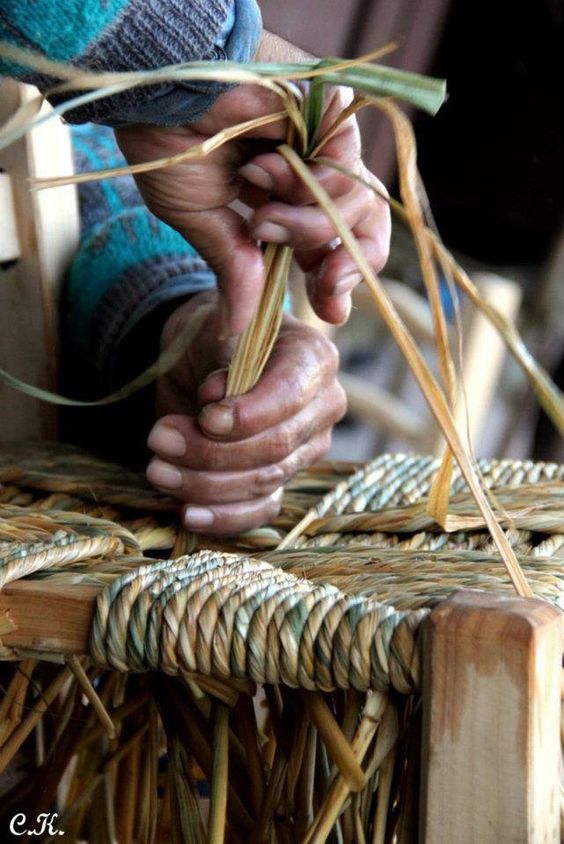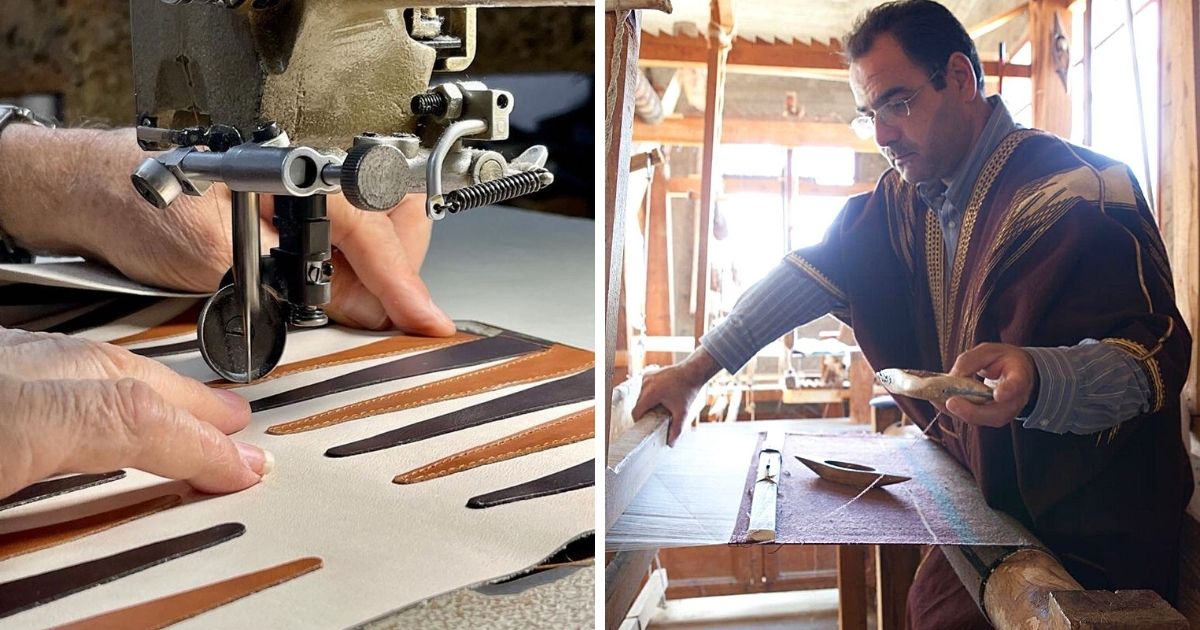Lebanon has a rich history dating back to the ancestors of this land, the Phoenicians, who were exceptional innovators, artists, and traders across the Mediterranean.
From the Phoenician civilization to the influence of foreign empires that had dominated our land, vestiges of these craftsmanships are still notable across the country.
Most importantly, today, are those that have been passed down from generation to generation and that are keeping the Lebanese Artistic Heritage alive, producing fascinating handmade craftworks.
Here are the most notable ones:
#1 The Art of Carpet Weaving

Carpet weaving is a fascinating art that uses wool or silk, or a combination of both, to create stunning carpets that warm and embellish homes, and would last for ages.
This ancient craftsmanship is still well alive in Lebanon, especially in the Bekaa valley where many skillful women continue to weave carpets and rugs by hand, using old tools, and the know-how learned in their families.
#2 Artistic cutlery and silverware
For centuries, the Lebanese people have been handcrafting cutlery and silverware that are timeless in beauty and elegance. This craftsmanship can be seen in many areas of Lebanon, notably in Jezzine from the 18th century.
#3 The Art if Handblown Glass
Glassmaking and glass blowing are ancient handicrafts in Lebanon that are being kept alive since the Phoenician era. Today, it is mostly seen in the south of Lebanon with very few artisans left.
#4 Natural soap making
Tripoli was one of the first cities in Lebanon to start making soap. The process is labor-intensive yet very beautiful. The traditional soaps are made from olive oil.
Nowadays, you can find traditional soaps with other ingredients and scents in many villages in Lebanon, as well as in Khan El Saboun souk in Tripoli.
#5 The culinary Art of Marzipan
Marzipan is a traditional Lebanese dessert made from almond paste and traditionally shaped like flowers.
#6 Pottery Craftmanship

Pottery craftmanship in Lebanon goes far back in time to the Phoenician civilization where the production of olive oil and wine was stored in tall pottery jars, and also the Arak. The craftsmanship included the production of platters, water jars, wine goblets, coffee cups, and more.
The art of pottery making is still alive in Lebanon and can be found in many villages like Beit Chabab, Rachaya, and others.
#7 The Art of Basket Weaving
Basket making is a very old handcraft made from palm leaves. It started in Lebanese villages centuries ago to hold the harvests of fruits and vegetables, and many other usages at home.
Worth noting that while these natural handmade baskets have been largely replaced in our homes by commercial ones of processed metal and plastic, the traditional Lebanese ones are healthier to use.
You can still find basket weaving in areas near Jbeil and Amchit, as well as in Tripoli.
#8 The Art of Straw Chair Weaving

The art of chair making by handweaving palms and straws is a mesmerizing yet intensive-work craft. For centuries, the traditional straw weaved chairs in their various forms were part of all Lebanese homes.
It is no longer the case. Nowadays, we mostly found them in remote areas as very few artisans are left to continue this artistic heritage. There remains one small factory in Tripoli.

That has also much to do with the lack of demands for these beautiful art pieces of furniture, although rattan and weaved chairs are nowadays an expensive trend around the world.
#9 The Art of Handmade Carpentry & Wood Carving
For thousands of years, as recorded in The Bible, Lebanon was the prime source of timber for woodworking. The wood of its Cedars was sought for its high quality and resistance to rot and insects.
The Lebanese Cedars built temples and palaces around the Phoenician Sea, all the way to Spain and Egypt, as well as the famous Phoenician ships.
Inland, the Phoenicians developed the art of woodworking, and not only using cedarwood, carving wood to create furniture, cups, plates, and ornamental items.
The craftmanship went further evolving with times, and it is very much alive in today’s Lebanon, where woodcarving is still in demand.
#10 Jewelry handicraft
The Phoenician woman was reputable across the region for her sense of fashion as well as her high intellect. The art of jewelry making was prominent back then as is today in Lebanon.
The technics have long evolved since then and Lebanese jewelry designers have been creating outstanding pieces sought after by the world’s royalties.
However, handmade jewelry is still being created in Lebanon, reflecting skills and elegant creativity.
#11 Mosaic Craftmanship
Mosaic craftmanship in Lebanon goes back to the Byzantine period where mosaic floors became essential in interior decoration and sacral spaces. Remnants of such were discovered in several parts of Lebanon, notably in Jiyeh.
Since that period, mosaic art became part of the artistic culture of the locals, prominent in many Lebanese architectures as well as furniture, murals, and ornamental items.
While it is not as spread as in the past, we can still find Lebanese artisans creating these mesmerizing pieces, even on-demand. In recent years, there have been works to revive this ancient craft that is part of Lebanon’s artistic heritage.
#12 Copper Artwork
The ancient craftsmanship of Copper artwork remains alive in Lebanon to date despite its frazzling and time-consuming process.
Such arts can be seen with traditional lamps, kettles, chandeliers, bowls, and plant pots in Baalbek, Tripoli, Jbeil, Qalamoun, and Beirut.
#13 The Art of Handmade Embroidery
The art of embroidery, using gold threads and beads of different shapes, continues to weave its way through the generations, embellishing garments and traditional Lebanese Abayas, as well tapestries and more.
Floral and other patterns are delicately woven with focus and precision to create beautiful pieces that last generations. Lebanese fashion designers also implement that art into their evening collections.
#14 The Art of Iconography
The exquisite art of iconography goes back to the Byzantine era and is believed to have been introduced to Lebanon’s artistic culture by the Orthodox Church.
It is a religious art that requires delicate precision and traditional procedures and rules where every color has a purpose and every fine detail a spiritual meaning.
Icons are very popular in Lebanon and are treated with veneration. Ancient and new decorate churches across the country. They are seen in many homes in the country, and some are passionate collectors of old and rare ones.
#15 Leather Craftsmanship
The craftsmanship of leather goods has evolved with time and remains part of Lebanon’s artistic heritage. Lebanese leather artisans have been creating elegant custom-made leather goods of all kinds and patterns that are a delight to the eyes.
#16 The Art Of Nawl Weaving
Nawl is a primitive impressive apparatus that allows skillful artisans to manually create exquisite textiles and garments, initially the traditional Lebanese Abaya of men and women.
The art of Nawl weaving requires precision and concentration and also tasteful creativity in the design of fine and intricate patterns and the inclusion of gold threads.
The textile known as Nawl is precious. It is so beautiful that it has been also used for other purposes than wearable, including decorative items.
Nawl machines are no longer common in Lebanon. They’ve become rare in the country but can be found and their handmade products in Chouf and the Old Souk of Zouk Mikhael.
Nawl products however are available for purchase across the country in artisanal stores, souvenir stores, as well as in Lebanon’s Souks.
#17 The Art of Stone Carving
The rich artistic heritage of carving stone goes back to ancient times where statues were created for deities, mythologies, and rulers but also to immortalize living beauty, and temple stones were finely carved in intricate congruous patterns.
Phoenician stone sculptures that have survived times speak of the antiquity of that craftsmanship in our land, such as the sarcophagus of King Ahiram of Byblos C13th-12th Century BCE), the torso from Sarafand( 6th century BCE), and many others one can admire in the National Museum of Beirut.
This absorbing and labor-intensive craftsmanship is still alive in Lebanon, some passed down from generation to generation in families and some acquired by apprenticeship.
#18 Crochet handicrafts
There is probably not a single Lebanese home that doesn’t have one or several homemade crochet textiles decorating a dining table or a side table.
If it is not the mother, it’s the grandmother who would be seen knitting tirelessly this delicate work in precise patterns while conversing with the family.
Artistic crochet is also seen decorating home textiles, bed linen, and more. Crochet is nowadays in fashion with women’s tops and even dresses knitted using the same technique.
#19 Plastering Craftsmanship
Delicate and elegant plastered elements can be seen in Lebanon’s heritage houses across the country, centering the ceilings where chandeliers lit the rooms and also bordering the top of the walls with intricate designs.
For centuries, plastering was an essential element in interior design as well as exterior in patios and external walls. That can still be seen across the country, all handmade.
And the legacy continues thanks to Lebanese artisans keeping it alive.
#20 Marquetry Craftmanship
The art of marquetry is a fascinating and delicate handicraft that originated in ancient Rome and spread throughout the Roman Empire, including old Lebanon.
The most ancient marquetry arts so far uncovered date back to the 1st century, in the ancient Roman towns of Pompei and Herculaneum.
In Lebanon, this artistic craftmanship is most relevant with the traditional Tawla (backgammon game) and similar table games like chess as well as jewelry boxes, trays, side tables, and chests.
Small pieces of veneer or mother pearls are applied to the wood in elaborated decorative patterns and designs to create mesmerizing art pieces of smooth surface.
#21 The Art of Bronze Casting and Molding
The Lebanese craftsmanship of bronze casting and molding goes back to the Phoenician civilization. According to World History, “Phoenician artists were known in antiquity for their fine metalwork.” The famous Phoenician Bronze Figurines are an example of that.
As recorded by History, King Solomon employed the craftsmanship of the Phoenician Hiram of Tyre to create two huge decorated bronze pillars for his temple in Jerusalem as well as some other bronze artwork.
Phoenician artists were also known in the region for their craftsmanship of highly crafted bowls they would create from bronze, silver, and gold.
Today, the legacy continues with some Lebanese artisans still handcrafting bronze and metal art by casting and molding.
















